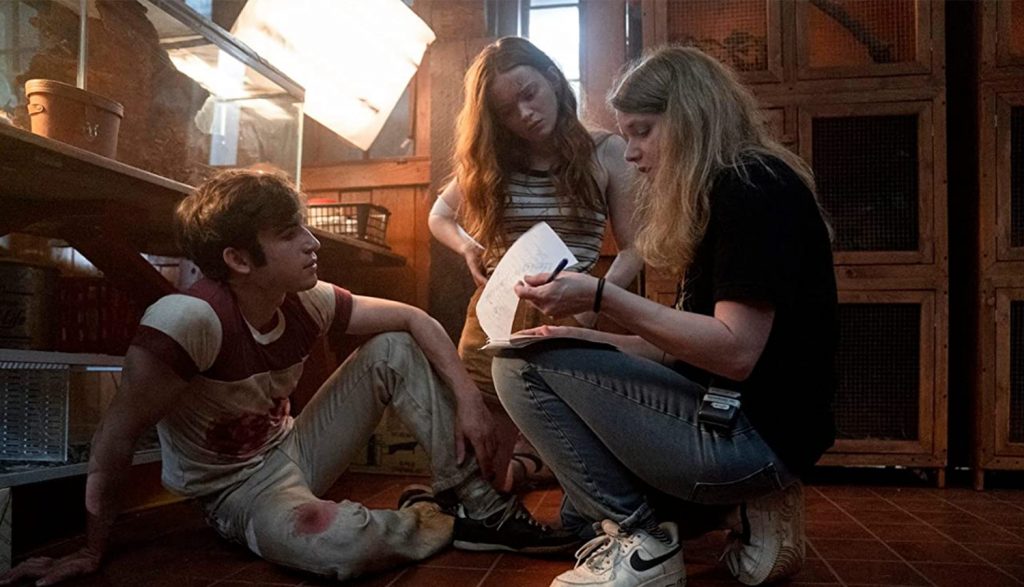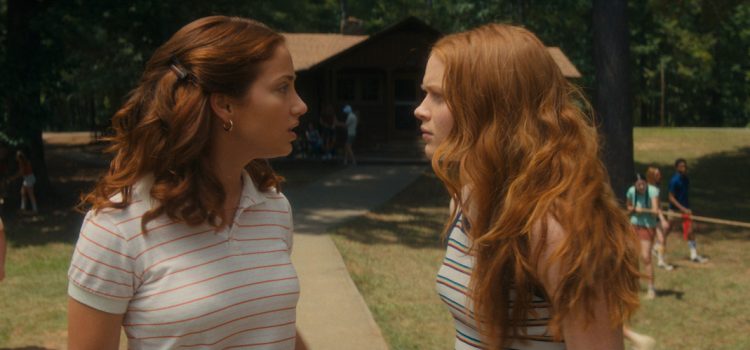By Alex McPherson
Director Leigh Janiak’s “Fear Street Part 2: 1978,” based on R.L. Stine’s novels, lacks the spark of the first installment, but still delivers a moderately engaging slasher throwback with bucketloads of gore.
After the ridiculous events of “Fear Street Part 1: 1994,” Deena (Kiana Madeira) and Josh (Benjamin Flores Jr.) meet up with C. Berman (Gillian Jacobs), a survivor of the 1978 Camp Nightwing massacre, hoping to learn how to end Sarah Fier’s witchy curse.
As the traumatized woman recounts her experiences, viewers are transported back to Camp Nightwing to witness what transpired. The protagonist is Cindy Berman (Emily Rudd), an uptight, goodie two-shoes camp counselor who becomes aggravated when other supervisors prioritize drugs and sex over doing their jobs. Her sister, the trouble-making Ziggy (Sadie Sink), holds a nihilistic view towards life — remaining an outcast among fellow campers, but a friend of counselor and future Shadyside sheriff Nick Goode (Ted Sutherland), as well as being a victim to nonstop bullying from mean girl Sheila (Chiara Aurelia), who insists that Ziggy’s an actual witch.
Just in time for the camp’s annual “Color War,” a capture-the-flag-esque event in which the vicious rivalry between Shadysiders and their stuck-up Sunnyvale neighbors rears its head in full force, things start to get creepy. After Nurse Lane (Jordana Spiro) violently confronts Cindy’s innocent boyfriend, Tommy Slater (McCabe Slye), suspicions arise as to whether Fier’s curse has returned. Cindy, accompanied by a few others including her ex-best friend, an irritating mumbler named Alice (Ryan Simpkins), attempt to find out what’s going on themselves. You guessed it, dear readers, all hell breaks loose, and the body count grows scene by scene. Can Cindy, Ziggy, and company make it out alive, or are they doomed to perish in a seemingly never-ending murder spree by an axe-wielding attacker?
Lacking the craftsmanship of “1994” regarding character depth and creativity, “1978” ends up being a fairly straightforward genre film that’s above average, but represents a downgrade from the trilogy’s opener. The second entry loses much of the adventurous fun of “1994,” coming across as rather dour, bleak, and unforgiving in comparison — full of cliches, yet promising better things to come in “Part 3.”
It’s clear that Janiak is attempting to tackle a different tone than “1994,” more akin to “Friday the 13th” than “Stranger Things.” In keeping with the change, “1978” begins rather generically once Berman begins her story, setting up the atmosphere of Camp Nightwing in a way that mostly doesn’t break from formula.
“1978” is a definite slow-burn compared to its predecessor, taking time to get underway, but effectively conveying a sun-drenched retreat with a dark heart and sickening future. Combined with a soundtrack of 70s era songs, Janiak once again captures the time period with a fitting attention to detail. In terms of camerawork, though, “1978” doesn’t feel as precise, featuring impressive tracking shots and spooky set design — enhanced by a sinister original score — but containing some dimly lit sequences and shaky cam that break immersion.
The batch of characters are decidedly inconsistent, but a few are explored meaningfully. Among them are Cindy and Ziggy, whose tensions are grounded in reality and easy to sympathize with. Living with a single parent and barely able to keep their house, the rift between them — with Cindy trying to support their family and Ziggy being increasingly pessimistic — is huge, but just like in “1994,” Janiak shows how frayed bonds can strengthen under shared threats. Rudd and Sink both give poignant performances and have solid chemistry with one another. Their dialogue is largely convincing, but interactions overall are missing the playful dynamic present in “1994.”
The “Shadyside Curse” rests at the heart of characters’ conflicts in “1978,” creating a sense of existential dread in their fates seeming out of their control — accentuated by Alice’s character, a young woman who uses drugs to compensate for her mental struggles. Nick Goode’s character is also cleared up a bit from “1994,” as he gradually falls for Ziggy and considers what the supernatural events entail for his career in Shadyside.
The remainder of the characters adopt boringly plain archetypes — the attention-seeking leader, promiscuous hippie, etc. — and viewers don’t spend much time with them before they’re graphically murdered (younger campers are often slain off-screen). They certainly have a lot of blood to spill, on the other hand. Indeed, “1978” almost goes overboard here, rendering many saps expendable fodder for the big baddie.
Speaking of, Janiak’s film feels limited by only having a single main threat for the characters to face, relegated to using a single weapon. “1994” was far more unpredictable in its kills, and while “1978” never ceases to shock, the violence starts to feel repetitive by the end credits. At least the sequences surrounding the destruction are more suspenseful this time around, feeling more frantic and distressing than before, as the leads scramble to save their friends and loved ones while trying to figure out what’s really going on.
With nearly as many flaws as strengths, “1978” fails to reach the heights of the original, but still offers its own gruesome, albeit unimaginative, pleasures. If nothing else, the film successfully builds hype for “Part 3,” which takes place in 1666 and details the background of Fier’s execution. There’s plenty more questions to answer and scares to be had, and I’m ready for the trilogy to surprise me once again.

“Fear Street Part 2: 1978” is part of a movie trilogy on Netflix, the first set in 1994 and the next one in 1666. Directed by Leigh Janiak, it stars Emily Rudd, Sadie Sink and Gillian Jacobs. Rated R for bloody horror violence, sexual content, nudity, drug use, and language throughout, its run time is 1 hour, 49 minutes. The movie began streaming on Netflix July 9. Alex’s Grade: B-
Alex McPherson is an unabashed pop culture nerd and a member of the St. Louis Film Critics Association.

